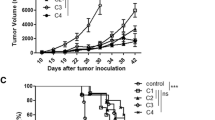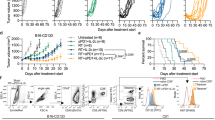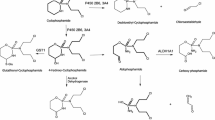Abstract
The TALL-104 cell line, originally derived from a patient with T cell leukemia, can be maintained indefinitely in culture in the presence of interleukin-2 (IL-2) and is endowed with a highly potent major-histocompatibilitycomplex (MHC)-non-restricted tumoricidal activity both in vitro and in animal models. The present study analyzes in detail the short- and long-term effects of irradiation and cyclosporin A (CsA) treatment on the growth and tumoricidal function of this T cell clone as compared to polyclonal lymphokine-activated killer (LAK) cell preparations from healthy donors. DNA and RNA syntheses by both TALL-104 and LAK cells were irreversibly arrested a few hours after irradiation with 40 Gy. However, 4-h51Cr-release assays, performed on different days (day 1 to day 7) after irradiation, showed that the cytotoxic efficiency of TALL-104 cells against hematopoietic and solid tumor targets was only modestly reduced, whereas that of LAK cells was severely inhibited. Moreover, the cytotoxic responses to recombinant human IL-2 and IL-12, measured 18 h after irradiation and cytokine addition, were normal in the case of TALL-104 cells but were abolished in the case of LAK cells. Co-culture of IL-2-or IL-12-preactivated TALL-104 cells with a tumor target for 5 days in the absence of cytokines resulted in a lower efficiency of lysis, as compared to the non-irradiated effectors, especially if the initial stimulus was IL-12. These findings suggest the requirement of multiple cytokine stimulation for optimal expression of tumoricidal activity by lethally irradiated TALL-104 cells. CsA, while abrogating TALL-104 cell proliferation at the low dose of 0.5 μg/ml, inhibited their cytotoxic function marginally only at high doses (100 μg/ml). By contrast, CsA reduced dose-dependently the cytotoxicity of LAK cells starting at very low doses (0.5 μg/ml). CsA did not impair the ability of TALL-104 and LAK cells to produce interferon (IFN)γ, tumor necrosis factor (TNF) α, and granulocyte/macrophage-colony-stimulatory factor (GM-CSF) in response to IL-2, IL-12, or tumor targets. Irradiation reduced drastically IFNγ production by LAK, but not TALL-104 cells; release of TNFα and GM-CSF by either type of effector was inhibited by 10%–50%, depending on the stimulus. The high resistance of the TALL-104 cells' tumoricidal function to irradiation and immunosuppressive drugs renders this immortal T cell clone a potentially safe and effective reagent for new adoptive-transfer approaches to cancer in MHC-incompatible recipients.
Similar content being viewed by others
References
Armentano D, Yu SF, Kautoff PW, VonRuden T, Anderson WF, Gilboa E (1987) Effect of internal viral sequence on the utility of retroviral vectors. J Virol 61: 1647
Bishop DK, Li V (1992) Cyclosporin A and FK 506 mediate differential effects on T cell activation in vivo. J Immunol 148: 1049
Cesano A, Santoli D (1992) Inducible expression of granulocytemacrophage colony-stimulating factor, tumor necrosis factor-α, and interferon-γ in two human cytotoxic leukemic T cell lines. In Vitro Cell Dev Biol 28A: 657
Cesano A, Santoli D (1992) Two unique human leukemic T cell lines endowed with stable cytotoxic function and different spectrum of target reactivity. Analysis and modulation of their lytic mechanisms. In Vitro Cell Dev Biol 28 A: 648
Cesano A, Visonneau S, Clark SC, Santoli D (1993) Cellular and molecular mechanisms of activation of MHC non-restricted cytotoxic cells by IL-12. J Immunol 151: 2943
Cesano A, O'Connor R, Lange B, Finan J, Rovera G, Santoli D (1991) Homing and progression of childhood acute lymphoblastic leukemias in severe combined immunodeficiency mice. Blood 77: 2463
Cesano A, Pierson G, Santoli D (1994) An effective and safe marrow purging strategy using a lethally irradiated killer T cell clone: In: Advances in bone marrow purging and processing. Wiley-Liss, New York, p 165
Cesano A, Visonneau S, Cioé L, Clark SC, Rovera G, Santoli D (1994) Reversal of acute myelogenous leukemia in humanized SCID mice using a novel adoptive transfer approach. J Clin Invest 94: 1076
Felgner PL, Gadek TR, Holm M, Roman R, Chan HW, Wenz M, Northrop JP, Ringold GM, Danielsen M (1987) Lipofection: a highly efficient, lipid-mediated DNA-transfection procedure. Proc Natl Acad Sci USA 84: 7413
Gershenfeld HK, Hershberger RJ, Shows TB, Weissman IL (1988) Cloning and chromosomal alignment of a human cDNA encoding a T-cell and natural killer cell-specific trypsin-like serin protease. Proc. Natl Acad Sci USA 85: 1184
Gilboa E, Eglitis MA, Kautoff PW, Anderson WF (1986) Transfer and expression of cloned genes using retroviral vectors. Biotechniques 4: 504
Gray CM, Stark JH, Smit JA, Myburgh JA (1992) Enhanced spontaneous and induced LAK function in baboons receiving total lymphoid irradiation (TLI). Scand J Immunol 36: 176
Halpern JN, Cohen E, Mekori T, Beny AN, Kuten A, Rosenblatt EA, Robinson E (1991) The effect of in vitro irradiation on human NK cell activity. A preliminary report. J Med 22: 243
Kaufmann Y, Levanon M, Davidsohn J, Ramot B (1987) Interleukin 2 induces human acute lymphocytic leukemia cells to manifest lymphokine-activated killer (LAK) cytotoxicity. J Immunol 139: 977
Keever CA, Benazzi A, Kernan NA, Welte K, O'Reilly R, Bordignon C (1988) Radiosensitivity of NK lytic activities and NK-mediated hematopoietic colony inhibition: effect of activation with IL-2 and blocking of the T-200 molecule. Cell Immunol 113: 143
Klaus GGB, Kunkl A (1983) Effects of cyclosporine on the immune system of the mouse. II. Cyclosporine inhibits the effector function of primary T helper cells, but not helper cell priming. Transplantation 36: 80
Kroczek RA, Black CDV, Barbet J, Shevach EM (1987) Mechanism of action of cyclosporin A in vivo. I. Cyclosporin A fails to inhibit T lymphocyte activation in response to alloantigens. J Immunol 139: 3597
Lee RE, Lotze MT, Skibber JM, Tucker E, Bonow RO, Ognibene FP, Carrasquillo JA, Shelhamer JH, Parrillo JE, Rosenberg SA (1989) Cardiorespiratory effects of immunotherapy with interleukin-2. J Clin Oncol 7: 7
Lotze MT, Custer MC, Bolton ES, Wiebke EA, Kawakami Y, Rosenberg SA (1990) Mechanisms of immunologic antitumor therapy: lessons from the laboratory and clinical applications. Hum Immunol 28: 198
Macklis RM, Mauch PM, Burakoff SJ, Smith BR (1992) Lymphoid irradiation results in long-term increases in natural killer cells in patients treated for Hodgkin's disease. Cancer 69: 778
Macklis RM, Mauch PM, Thompson L, Burakoff SJ, Smith BR (1993) Phenotypic and functional analysis of expanded natural killer cell subpopulations in Hodgkin's disease patients treated with lymphoid irradiation. Oncology 50: 323
Nakagawa K, Omori N, Hashimoto K, Yamamoto T, Tsunoda T, Nose T (1992) The combined effect of lymphokine-activated killer cells and radiation therapy on rat brain tumor in vitro. Biotherapy 4: 109
Nisticó P, Mortarini R, De Monte LB, Mazzocchi A, Mariani M, Malavasi F, Parmiani G, Natali PG, Anichini A (1992) Cell retargeting by bispecific monoclonal antibodies. Evidence of bypass of intratumor susceptibility to cell lysis in human melanoma. J Clin Invest 90: 1093
O'Connor R, Cesano A, Lange B, Finan J, Nowell PC, Clark SC, Raimondi SC, Rovera G, Santoli D (1991) Growth factor requirements of childhood acute T lymphoblastic leukemia: correlation between presence of chromosomal abnormalities and ability to grow permanently in vitro. Blood 77: 1534
Pereira GMB, Miller JF, Shevach EM (1990) Mechanism of action of cyclosporine A in vivo. II. T cell priming in vivo to alloantigen can be mediated by an IL-2-independent cyclosporine A-resistant pathway. J Immunol 144: 2109
Rosenberg SA, Lotze MT, Muul LM, Leitman S, Chang AE, Ettinghausen SE, Matory YL, Skiller JM, Shiloni E, Vetto JT, Seipp CA, Simpson C, Reichert CM (1985) Observations on the systemic administration of autologous lymphokine-activated killer cells and recombinant interleukin-2 to patients with metastatic cancer. N Engl J Med 313: 1485
Rosenberg SA, Lotze MT, Muul LM, Chang AE, Avis FP, Leitman S, Linehan WM, Robertson CN, Lee RE, Rubin JT, Seipp CA, Simpson CG, White DE (1987) A progress report on the treatment of 157 patients with advanced cancer using lymphokine-activated killer cells and interleukin-2 or high dose interleukin-2 alone. N Engl J Med 316: 889
Rosenberg SA, Lotze MT, Yang JC, Aebersold PM, Linehan WM, Seipp CA, White DE (1989) Experiences with the use of high-dose interleukin-2 in the treatment of 652 cancer patients. Ann Surg 210: 474
Shevach EM (1985) The effects of cyclosporin A on the immune system. Annu Rev Immunol 3: 397
Takahashi H, Nakada T, Puisieux I (1993) Inhibition of human colon cancer growth by antibody-directed human, LAK cells in SCID mice. Science 259: 1460
Takaori K, Nio Y, Inoue K, Tun T, Fukumoto M, Hashida T, Yasuhara M, Hori R, Tobe T (1992) A comparative study on immunosuppressive effects of cyclosporin A and FK 506 on peripheral blood lymphocytes in dogs. Biotherapy 4: 129
Thomson AW (1991) The immunosuppressive macrolides FK-506 and rapamycin. Immunol Lett 29: 105
Trapahi JA, Klein JL, White PC, DuPont B (1988) Molecular cloning of an inducible serine esterase gene from human cytotoxic lymphocytes. Proc Natl Acad Sci USA 85: 6926
West WH, Tauer KW, Yannelli JR, Marshall GD, Orr DW, Thurman GB, Oldham RK (1987) Constant-infusion recombinant interleukin 2 in adoptive immunotherapy of advanced cancer. N Engl J Med 316: 898
Young JD, Liu CC, Persechini PM, Cohn AZ (1988) Perforindependent and independent pathways of cytotoxicity mediated by lymphocytes. Immunol Rev 103: 161
Author information
Authors and Affiliations
Rights and permissions
About this article
Cite this article
Cesano, A., Visonneau, S., Cioé, L. et al. Effects of lethal irradiation and cyclosporin A treatment on the growth and tumoricidal activity of a T cell clone potentially useful in cancer therapy. Cancer Immunol Immunother 40, 139–151 (1995). https://doi.org/10.1007/BF01517345
Received:
Accepted:
Issue Date:
DOI: https://doi.org/10.1007/BF01517345




